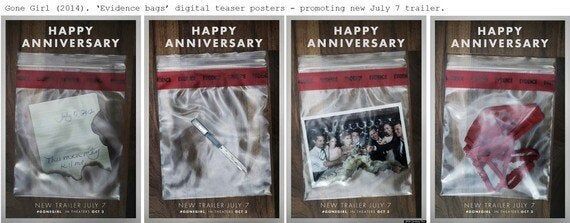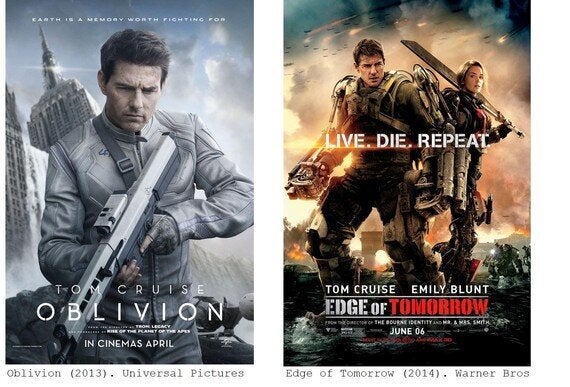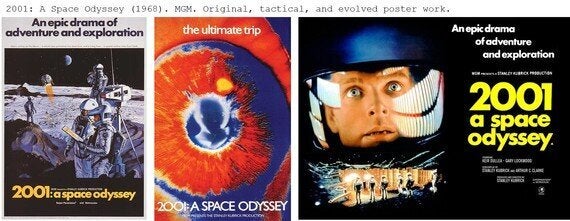The Jazz Singer. 1927. A major commercial hit for Warner Brothers and a motion picture watershed. The 'talkies' had arrived, 'the silent movie' bowed into the shadows, and into the 1930's and 40's stepped the likes of Citizen Kane, Walt Disney, Gone with the Wind, The Wizard of Oz, Hitchcock, Kapra and Casablanca. The 'Golden Age' of cinema.
Movie lovers could debate long into the night whether the 1970's represented a second kind of 'Golden Age' - and debate could further rage as to whether we're currently witnessing a third Golden Age of cinema.
Consider this century. We've had Gravity and Avatar and the ever-expanding Marvel universe; Jack Sparrow and Disney finding their mojo with Frozen; Pixar's Nemo, Buzz and Woody; Nolan's Batman; Bourne and Bond rebooted; and The Potter, Hobbit and Hunger Games franchises.
Of the current 19 highest grossing films of all time (those being movies with a worldwide box office over the magic $1bn), 16 of those movies have been this millennium. Within the top 40 highest grossing movies of all time, only 4 movies date before 2000. Of course, not adjusting for inflation and the increasing cost of cinema tickets biases these numbers - but irrespective of adjustments, we are seeing the expenditure of much gold up there on our silver screens, and a global movie industry where the stakes and investments have never been higher.
JUST IMAGINE
Making a movie is seldom, if ever, cheap. Even those indie breakthroughs like Clerks and Blair Witch involved real people fronting their very real money. And at the other end of the spectrum, you have evermore annual tent poles rising on production budgets (un)comfortably north of $175m dollars. In support of that investment, you may well see some part (poster, trailer etc) of a global marketing campaign that cost a figure similar to production.
Imagine a $400m exposure? Just imagine you've cut all those cheques, while your brainpan itches with the recollection of how Disney took a $200m hit on John Carter - or you think farther back to movies like Heaven's Gate and Ishtar, or Catwoman and Cutthroat Island? The wrong kind of pirates can fail, Halle Berry in a figure-hugging cat suit is no guarantee, and even casting Matthew McConaughey and having him take his shirt off still might not turn out as 'awright' as hoped. 2005's Sahara generated a relatively strong $122m box office... but cost over $241m to make. No one builds a career on those kinds of ratios.
The reality is that 'too big to fail' is no kind of logic, and that movies can tank for all kinds of reasons. Even good ones. Timing is one key variable.
Hard to believe, but It's a Wonderful Life was a loss-maker for RKO on its release in 1946. It went up against Miracle on 34th Street and The Best Years of Our Lives. Easier to believe, World War 2 reduced Hollywood's international release market by 60%. In consequence MGM's The Wizard of Oz and Walt Disney's Pinocchio, Fantasia and Bambi all underperformed.
Now for the good news. The cautionary tales are instructive, and while there's no sure-fire way to snare lightening in a bottle, movie-marketing is being invited to experiment and express like never before.
BY BRILLIANT EXAMPLE
During a recent interview in The Hollywood Reporter, Tomas Jegeus (co-president of worldwide marketing and distribution at 20th Century Fox) acknowledged, "the increasing cost (of marketing a movie) is a massive challenge. Yet it's not how much you spend", he added, "it's the message. If we don't have the message right, nothing else matters". Ultimately, Jegeus is talking to the fine art of knowing exactly what and what not to say.
In the case of Fox's Gone Girl, Jegeus exampled, "We couldn't allude to the twist, so we couldn't tell half the story. We focused the whole campaign on Ben Affleck's character. Once the movie opened, we decided we could say more."
This summer's Gone Girl campaign was a treat. The proposition was perfectly judged and crafted, and of all the creative assets, the 'Evidence bags' posters (promoting the July 7 trailer) were further evidence of 'transmedia marketing' as it can be done.

Boil it right down, and movie-marketing is all about the WHAT, WHERE and WHEN.
WHAT to say (message and execution).
WHERE to say it (media).
And WHEN (timing).
But that's not to say marketing a movie is easy. Far from it.
This summer's Edge of Tomorrow (make that: Live Die Repeat) provided vivid example of how a studio initially got the message wrong, and later marketed it right.
The title, Edge of Tomorrow, did the movie no favours. It sounds bland. Translate it into other languages, and it barely makes sense (not that it makes that much sense in English). Then compare its final theatrical poster work with Tom Cruise's previous dystopic/sci-fi/blockbuster, Oblivion.

Audiences could be forgiven for thinking it was the same movie. Which is all a shame, because both movies are very good.
'Live. Die. Repeat.' however is a great (central premise) tag line, which became ever-larger in creative executions as Warner Brothers' campaign progressed. For the movie's Home Ent digital and disc release, the tag line had usurped the original title, effectively becoming the far better title.
The happy lesson in this is that it's not necessarily too late to tactically adjust.
Kubrick's 2001: A Space Odyssey is another example of how they ultimately - rather than initially - got the messaging right.
In 1968, 2001 polarised critics. Some gushed. Others just didn't get it, and audiences initially inclined to the latter. On the basis of poor early box office, MGM were going to pull the movie. Exhibitors however reported to MGM that 2001 was gaining popularity with younger audiences, some of whom were eschewing popcorn in favour of "funny cigarettes" and LSD as they tripped their way through the movie's psychedelic star gate sequence at the end of the second act.
In response, MGM marketing conceived a tactical poster months after the initial release: '2001: The ultimate trip'. You can see how the movie's poster work evolved, the early illustrative work then inculcating the tactical creative, culminating in later theatrical posters that re-positioned the movie.

Whether 1968, 2001, or 2014, the delivery of What, Where and When requires invention and playfulness. How you tease. What you reveal. When you reveal it. What you hold back.
As a piece of compelling articulation, I'm a huge fan of Studio Canal's tagline for The Imitation Game. "The true Enigma was the man who cracked the code."
Churchill famously described Russia as "a riddle wrapped in a mystery inside an enigma." The description could as easily stand for what the best teaser marketing looks to achieve.
I absolutely loved the 50" teaser for this Autumn's Nightcrawler. It's a character portrait. A perfectly honed, performed and edited piece of content in its own right; the thinnest slice of a movie you can't wait to feast on.
And while Nightcrawler's later official trailer ably did what it had to do, I wondered whether it fell into the trap of so many final trailers, of showing and telling too much of the movie to come? Trailers are at their weakest when they become über-abridged versions of the final cut they're promoting. They are at their best when we're left still wanting.
Left 'still wanting' is certainly what the recent trailer for Eastwood's 2015 American Sniper achieves. Like the Nightcrawler teaser, it's a 'standalone' piece of content, a 1 min 40 scene that hurls you instantly into the moment, positing, "What would you do?"
This October, the final trailer for the independently produced Keanu Reeves actioner John Wick also played a blinder. Where 47 Ronin was a poorly marketed Last Samurai/Airbender mash-up that compelled few, John Wick was the very opposite: a Death Wish style/80's throwback that plays it deadpan, while knowing exactly what it is and how it's ironic.
The Wrap hailed the R-rated action thriller "a financial coup for Lionsgate's Summit Entertainment, taking $14.1 million in its opening weekend, double the projection of some analysts and more than $5 million better than the debut of Reeves' 2013 mega-bomb 47 Ronin."
John Wick was the right message. And it supported a smart theatrical window. When Fox's Colin Firth spy thriller "Kingsman: The Secret Service" pushed its Oct 24 release to next February, Lionsgate pounced. "That opened up this weekend", explained Lionsgate's Richie Fay, "when the main competition would be Ouija, which skewed young and female -- the opposite of the demo target for John Wick."
Lionsgate should also consider adding actress Elizabeth Banks to their marketing payroll. Check out her (pro)activity on Instagram and Twitter in the build up to Mocking Jay Part 1. Bank's considerable ability to independently promote the movie's she stars in can only strengthen any decision to cast her. Patrick Stewart obliquely spoke to this very point in his address at this year's Cannes Lions. Stewart and McKellan's use of Twitter to gain following and ultimately draw attention to their Broadway play was an exercise in celebrity (re)branding and broadening your consumer base.
A few well-judged tweets and it turns out Professor X and former USS Enterprise captain is one self-deprecatingly comic guy. Who knew? Very few, until Patrick Stewart showed us.
And no mention of this year's star turns would be complete without mention of Marvel, and how one supervillain's act of sabotage can be another superheroes' viral 'pheno-meme'.
The most popular movie trailer of all time was a trailer no one was meant to see. Marvel's 'leaked' Age of Ultron teaser was up to 45m views after 6 days and provided the perfect drum roll ahead of the studio's October 28th Phase 3 announcement: a 9 movie batch over the next 5 years. There are certainly no strings on studio president Kevin Feige.
Of course, The Avengers is an established franchise with a strong and simple premise. But the point is that any premise is only strong and simple once you've made it that way. Genre-busting films like Blade Runner and Donnie Darko generated dismal initial box office because they got the better of the marketing minds that failed to effectively position and articulate them.
Back in 1964, it would have been just as easy to get the message wrong with Sergio Leone's ground-breaking A Fistful of Dollars. Instead, United Artists struck gold. 'The Man with No Name' was a piece of pure marketing invention that gave mystique and cohesion to the spaghetti western franchise.
Fifty years later, and the 50 Paddington bear statues around London to promote the forthcoming movie is a similar act of marketing genius - the evocation of an iconic character that adds extra charm to the streets of London at Christmas time, as well as generating income for the NSPCC.
GOLDEN OPPORTUNITIES
In the movie industry, 'entertainment' is the thing of manufacture. There's an investment in a tangible product, which everyone involved in the making hopes will sell. But hope is not enough and selling a movie is no fair-weather, plain-sailing task.
On the one hand, you have audience fragmentation, spiralling media costs, and an audience's tech-assisted ability to edit and ignore. On the other (which is where it gets exciting), you have a digital playing field, transmedia story-telling, and the potential to grab pop culture by the throat.
A third Golden Age of cinema may be hotly debated, but movie-marketing is being granted opportunities that are surely golden enough.
